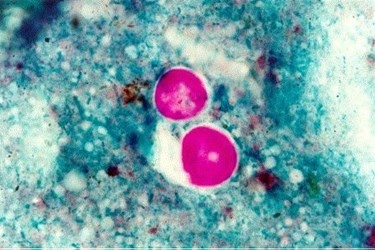Ongoing-Cyclosporiasis Outbreak Sickens More Than 200
By Laurel Maloy, contributing writer, Food Online

A source has yet to be identified in the most recent cyclosporiasis outbreak, which now encompasses 19 states and New York City
Since July 25, the Cyclosporiasis outbreak without a known source has grown to more than 200 cases in 19 states. The majority of the cases are in Texas, where it was first classified as an outbreak, when the number of ill persons noticeably jumped to 61. Cases in Texas total 160 in 37 counties with 18 other states also having reported cyclosporiasis infections. This number is up from 13 in July.
The states involved, includes: CA, CT, FL, GA, IL, MA, ME, MD, MI, MN, MT, NJ, NY, OH, OR, TN, VA, and WI. According to the TX Department of State Health Services (DSHS), the source has yet to be identified.
The Top 10 Most-Concerning Foodborne Parasites
Past outbreaks of cyclospora, caused by a single-celled coccidian protozoan, Cyclospora cayetanenis, are most often associated with imported fresh produce. Presenting just like any number of gastrointestinal illnesses, the very first sign may be diarrhea, sometimes excessive and watery. Accompanied by a headache, fever and fatigue, many people and health professionals first believe it is a form of influenza or another stomach virus. Additional symptoms include nausea, vomiting, malaise, anorexia, and abdominal cramps. Though no deaths have been reported to date, the elderly, the very young, and those with a compromised immune system are most at risk for severe complications and hospitalization. Anyone experiencing symptoms for more than a few days should consult a medical profession.
The possible sources for Cyclospora cayetanenis food poisoning include:
- Eating food from a cyclospora-infected animal
- Consuming food or water contaminated by someone infected with cyclospora
- Coming into contact with cyclospora-contaminated soil or water
- Person-to-person contact
- Infection by touching a contaminated surface
Treatment most often includes supportive therapy, such as fluid replacement, possibly intravenously, and antibiotics containing trimethoprim-sulfamethoxazole. These antibiotics are often sold under the brand names Bactrim, Septra, and Cotrim. Those allergic to sulfa drugs or who do not respond to this standardized treatment do not have the option for using any other highly effective alternatives; there are none.
Improving Quality Assurance In The Meat And Seafood Cold Chain
Since no source has yet been identified, the potential for infection continues. The source for the infection could still be shipping products globally. It is recommended that washing produce thoroughly be utilized as a precautionary measure, however, cyclospora is difficult to wash off. According to the Centers for Disease Control and Prevention (CDC), chlorine and iodine are unlikely to kill cyclospora, which makes it difficult to prevent cross-contamination throughout the food supply chain. The Guide to Minimize Microbial Food Safety Hazards for Fresh Fruits and Vegetables was published by the FDA in 1998. In addition to these practices, industry is encouraged to utilize good agricultural practices (GAPs) and good manufacturing practices (GMPs) in order to minimize the spread of cyclospora.
